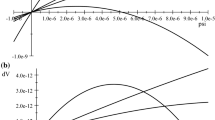Abstract
The objective of this paper is to consider the following question. Does the presence of increasing returns introduce a fundamental trade-off between equity and efficiency objectives? We show that if the no-envy notion of Foley (1967) is taken as the equity criterion and Pareto optimality as the efficiency criterion, then the answer is yes; there exist economies with increasing returns and well-behaved preferences (and no agent-specific inputs) in which there do not exist any envy-free and Pareto optimal allocations. We also propose a weakening of the no-envy criterion and prove that this weaker equity notion is compatible with Pareto optimality in general non-convex economies.
Similar content being viewed by others
References
Beato P, Mas-Colell A (1985) On marginal cost pricing with given tax-subsidy rules. J Econ Theory 37: 356–365
Brown D.J, Heal GM (1979) Equity efficiency and increasing returns. Rev Econ Stud 46: 471–485
Brown DJ, Heal GM (1985) The optimality of regulated pricing: a general equilibrium analysis. In: Aliprantis CD, Burkinshaw O, Rothman NJ (eds) Adv Equilibrium Theory. Berlin, Heidelberg, New York, Springer
Cornet B (1988) General equilibrium theory and increasing returns (special issue) J Math Econ 17
Daniel T (1978) Pitfalls in the theory of fairness-comment. J Econ Theory 19: 561–564
Diamantaras D (1989) On equity with public goods (mimeo, Temple University)
Feldman A, Kirman A (1974) Fairness and envy. Amer Econ Rev 64: 995–1005
Foley D (1967) Resource allocation and the public sector. Yale Econ Essays 7: 45–98
Guesnerie R (1975) Pareto optimality in non-convex economies. Econometrica 43: 1–29
Hurwicz L, Reiter S (1973) On the boundedness of the feasibility set without convexity assumptions. Int Econ Rev 14: 580–586
Moulin H, Thomson W (1988) Can everyone benefit from growth? Two difficulties. J Math Econ 17: 339–345
Pazner E, Schmeidler D (1974) A difficulty in the concept of fairness. Rev Econ Stud 41: 441–443
Pazner E, Schmeidler, D, (1978) Egalitarian equivalent allocations: a new concept of economic equity. Quart J Econ 92: 671–687
Scarf HE (with the collaboration of Hansen T) (1973) Computat Econ Equilibria, Yale University Press, New Haven
Svensson LG (1983) On the existence of fair allocations. Zeitschr Nationalokon 43: 301–308
Thomson W (1989) Equity concepts in economics (mimeo, University of Rochester)
Varian H (1974) Equity, envy and efficiency. J Econ Theory 9: 63–91
Vohra R (1988) Optimal regulation under fixed rules for income distribution. J Econ Theory 45: 65–84
Vohra R (1990) On the inefficiency of two-part tariffs. Rev Econ Stud 57: 415–438
Author information
Authors and Affiliations
Additional information
I am indebted to W. Thomson for many helpful discussions. Thanks are also due to D. Diamantaras and B. Dutta and to participants of seminars at Columbia University, University of Bielefeld, University of Alicante and Cornell University for comments on an earlier draft.
Rights and permissions
About this article
Cite this article
Vohra, R. Equity and efficiency in non-convex economies. Soc Choice Welfare 9, 185–202 (1992). https://doi.org/10.1007/BF00192877
Received:
Accepted:
Issue Date:
DOI: https://doi.org/10.1007/BF00192877




